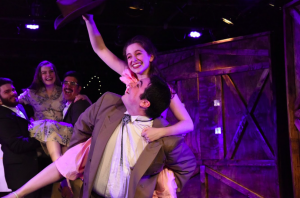Content warning: This article includes mentions of physical violence and sexual assault.
Mask and Bauble Dramatic Society’s latest musical, Sweeney Todd: The Demon Barber of Fleet Street, is a tale of vengeance, cannibalism, and murder. Running from April 3–11, the performance is both gritty and hilarious, and the music will stay with you long after the actors have taken their final bows.
Sweeney Todd tells the story of Benjamin Barker (Massimo D’Onofrio, CAS ’28)—a barber who returns to England after 15 years of exile in Australia. Set in 19th-century London, Barker, who has renamed himself Sweeney Todd, vows to get revenge on Turpin (Jack Kealey, CAS ’25), the man who raped his wife (Hannah Beil, CAS ’28) and falsely convicted Todd of a crime. Luckily for Todd, Mrs. Lovett (Daisy Casemore, CAS ’26), the owner of a failing pie shop, is willing to collaborate—by baking Todd’s murder victims into her pies.
Told almost entirely through song, the musical is considered one of Stephen Sondheim’s most vocally challenging. The dark, emotional songs feature remarkably high notes and rapidly changing tempos—making the cast’s outstanding performance impressive. The opening group number, “The Ballad of Sweeney Todd,” sets a high bar for the rest of the musical, eerily foreshadowing Todd’s descent into villainy. The remainder of the songs—backed up by a pit orchestra of students—only gets better from there.
The music in Sweeney Todd is intense, but every member of the cast gives their all. Beil, who also plays Todd’s daughter, Johanna, is particularly impressive. Beil both handles her character’s exceptionally high notes with ease and conveys the sadness behind the lyrics. Her voice is longing as she attempts to escape her old life. While every cast member shines brightly on their own, they shine even brighter together. The opening number, “Pirelli’s Miracle Elixir,” “God, That’s Good!” and “City on Fire” are especially notable for their complicated choreography and chorus of overlapping voices.
The ensemble adds complexity to the show. As each member changes roles throughout the musical—sometimes Turpin’s accomplices, sometimes Todd’s victims—they force the audience to question whether they, too, are implicated. For example, at the ball where Turpin rapes Lucy, Todd’s wife, the ensemble is complicit in her assault as they block Lucy in, preventing her escape.
For a show about cannibalism, Sweeney Todd is surprisingly hilarious. Although the darker moments certainly drive the show, the cast also leans into the humorous elements, emphasizing the absurdity through comedic pauses and fourth wall breaks. During “Pirelli’s Miracle Elixir,” Todd attempts to steal customers away from rival barber Adolfo Pirelli (Jack Markowitz, CAS ’27) by informing them that the so-called cure for hair loss is, in fact, urine. Tobias Ragg (Stratton Rebish, CAS ’28), Pirelli’s young assistant, is the highlight of this song; as he sings about his miraculous hair transformation, he makes direct eye contact with the audience, pitching the product to viewers as well as the ensemble.
The musical is an immersive experience. Every inch of the stage is occupied, whether by dancing, a quickly constructed restaurant, or a dramatic escape from the city’s asylum. But rather than being distracting, this frenzy serves to draw the audience in. As the viewers are shown around London, the city begins to come alive.
Just as the actors flesh out their characters’ backstories, the constantly changing set creates a sense of place. As the musical progresses, it only gets more complicated; the walls are pulled away to reveal new rooms and Todd’s drab barber shop gets an aesthetic upgrade after intermission. In Act II, as Todd grows angrier and more unstable, the set adapts to his needs. His barber chair retracts into the wall for easier disposal of the bodies, and viewers are able to see the ovens Mrs. Lovett uses to bake her pies—a piece of the set previously hidden behind walls.
While the set is well-designed, it’s the costumes that truly immerse the audience in 19th-century London. Each garment is intricately crafted, reflecting each character’s unique personality. Mrs. Lovett’s patchwork skirt shows off her eccentricity, Johanna’s white lace dress is the picture of innocence, and Pirelli’s brocade overcoat is just as extravagant as he strives to be.
For all their humor, the cast of Sweeney Todd ensures the comedy does not overshadow the show’s more grim themes. With frequent appearances by the character simply named “Beggar Woman” in the program (Ruth Abramovitz, CAS ’27), viewers are made privy to how each character understands poverty. Additionally, in Act II, when Anthony (Nate Findlay, CAS ’27),a young sailor in love with Johanna,goes to rescue her from the asylum she is imprisoned in, the audience bears witness to the uncomfortable truth of how people with mental illnesses were treated in 19th-century London.
Mrs. Lovett, who both drives the show’s comedy and supports Todd in his gruesome quest for revenge, exemplifies how the show balances humor and solemnity. Casemore plays up her hilarity through her sarcastic tone of voice and her variety of dramatic facial expressions, keeping the audience rapt through songs like “By the Sea”—which is both incredibly long and fast-paced. By granting us glimpses of pure panic and desperation, Casemore allows the audience to see Mrs. Lovett be swept up in Todd’s crimes in real time. In presenting Todd’s accomplice as a sympathetic character, the show has us reconsider our conceptions of good and evil.
Ultimately, Sweeney Todd is bloody hilarious, yet the members of Mask and Bauble have also managed to convey many of the show’s darker, more profound themes in a way that is accessible to a general audience. Without a doubt, this murderous musical masterpiece is quite a feat.





